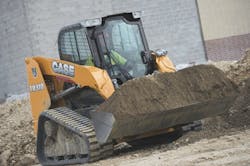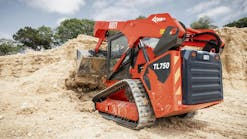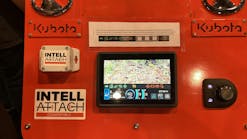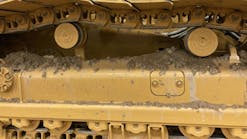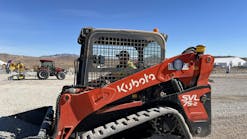Case TR310 Compact Track Loader
Editor's note: This model has been upgraded to Case B Series compact track loaders. See more below.
The Case TR310 Alpha Series compact track loader has an operating weight of 8,800 pounds and rated operating capacity of 3,100 pounds. The Tier 4-Final CTL has a 74-horsepower engine that uses cooled exhaust gas recirculation with a diesel oxidation catalyst and high-efficiency flow-through filter. The machine has 232 lb.-ft. of torque, and standard hydraulic flow is 24.2 gpm with 32.4 gpm at high-flow. Tracks are 15.75 inches wide with 5.0 psi of ground pressure. With radial-lift arm design, the CTL’s hinge-pin height is 10 feet 3 inches.
Case TR310 Specs
- Operating weight: 8,800 pounds
- ROC: 3,100 pounds
- Power: 74 horsepower
An EZ-EH (electro-hydraulic) setup menu has nine optimal preset speed and control settings. A single rocker switch allows operators to switch between the Case “H” operating pattern and ISO pattern controls, and new handles with Case-exclusive detents that allow the operator to physically feel when the joystick is coming out of neutral.
The enclosed cab measures nearly three feet wide and is fully sealed and pressurized against noise and dust. The engine, filters and fill points are all located at the rear of the machine for quick and easy access.
Case TR310B Specs
- Operating weight: 8,800 pounds
- Power, net: 68 horsepower at 2,500 rpm
- ROC, 35%: 2,170 pounds
The Case B Series loaders feature a completely redesigned operator interface, including new left- and right-hand posts with simple ignition, push-button operation, easy throttle control, and intuitive switches for all core machine functions. Available are standard mechanical, mechanical hand-and-foot, and electro-hydraulic controls.
The loaders have 360-degree visibility, including a backup camera. An 8-inch LCD multifunction display includes the view from the backup camera in a split-screen display with machine data. The camera is operational in both forward and reverse.
The low entry threshold and large front window provide visibility to the front of the machine and down to the attachment. Large side windows and a large curved rear window allow for sight lines to the sides and the rear of the machine. Rear visibility is further aided by low-profile rear hoods, and an extremely low-profile H-Link on vertical-lift models that does not impede visibility to the rear.
